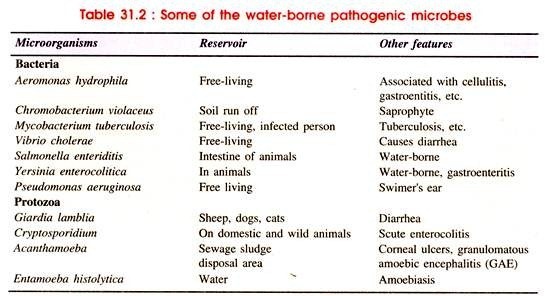ADVERTISEMENTS:
In this article we will discuss about the composition of sewage.
Sewage is the used and wastewater consisting of human excreta, wash waters, and industrial and agricultural wastes (e.g. wastes from live stock i.e. chicken, cattle, horse, etc.) that enter the sewage system. In general sewage contains about 95.5% water and 0.1 to 0.5% organic and inorganic materials.
The solid remains in suspended form in water. The celluloses, lignocelluloses, proteins and fats are found in colloidal form in water. The other inorganic materials are dissolved and are found in ionic forms.
ADVERTISEMENTS:
From the industries disposed wastes consist of detergents, antibiotics, paints, biocides, etc. The pulp and paper industries discharge cellulosic and inorganic chemicals.
Therefore, sewage composition differs with types of industrial effluents discharged into sewage systems:
(i) The Sewage Microorganisms:
A variety of microorganisms are present in water for example bacteria, fungi, protozoa, algae, nematodes, amoebae and viruses. Some of the common pathogenic microorganisms are given in Table 31.2.
The microorganisms are aerobes, obligate anaerobes and facultative anaerobes present in millions in one milliliter of sewage. Most of them are intestinal and soil bacteria. The common bacteria are coliforms, streptococci, micrococci, lactobacilli, Clostridia, pseudomonads, etc.
The other pathogens are those causing amoebic dysentery, cholera, typhoid fever, bacterial dysentery, polio, hepatitis, etc. These organisms are heterotrophs and thus decompose organic matter of sewage.
In the beginning aerobic bacteria dominate and decompose organic material and at the end anaerobic bacteria predominate (e.g. methanogens) which produce methane (CH4), carbon dioxide (CO2) and hydrogen (H2) gases. By collecting sewage now-a-days several biogas plants are being operated in Bombay, Okhla (Delhi) and Kanpur where biogas is supplied in selected villages for lighting and cooking purposes.
(ii) BOD and COD:
In the initial stage of decomposition of organic materials of sewage, aerobic microorganisms are involved. These completely oxidise the organic materials under aerobic condition rendering into complete stabilization of sewage.
During this process, all the dissolved oxygen is consumed for oxidation of organic materials. Consequently there develops anaerobic conditions in water which results in death of water animals and emitting foul smell due to incomplete oxidation of organic materials in sewage.
This occurs because the wastes have now high biochemical oxygen demands (BOD) required by the aerobic bacteria which the sewage has no more oxygen to bring about oxidation process. Thus, BOD is the amount of oxygen required by organisms in water under certain standard conditions.
The sewage of high organic material has high BOD value and vice versa. Thus, BOD is the important indication of levels of biological pollution in water, and provides an index of the amount of microbially oxidizable organic matter.
One can measure BOD in the laboratory. Test sample of water is taken in BOD bottles. Initially, the level of dissolved oxygen in the water sample is determined. Thereafter, bottles are stoppered at 20°C. After incubation for five days the amount of dissolved oxygen is again measured. The difference in oxygen values is the BOD which denotes the amount of oxygen utilized within five days. BOD is expressed as parts per million.
ADVERTISEMENTS:
On the other hand, chemical oxygen demand (COD) is the amount of chemical oxidation required to convert organic matter in water and wastewater to carbon dioxide.

